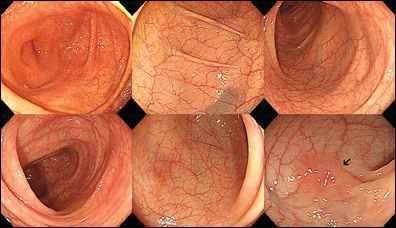Improved Bowel Prep Leads to Improved ADR
I Have Trouble Doing a Complete Colonoscopy in Some of My Patients Because of Poor Bowel Preparation. What Should I Do to Ensure a Properly Prepared Colon?
Click Here to Manage Email Alerts
With the increasing evidence that screening, either with a fecal occult blood test or colonoscopy, can prevent colorectal cancer, the demand for colonoscopy has increased remarkably. The discomfort accompanying an endoscopic examination can be efficiently reduced by conscious sedation, but ingesting purgatives for bowel preparation, according to many examinees, is the worst part of the colonoscopy experience. Nevertheless, when using PEG-ELS (polyethylene glycol-electrolyte lavage solution) or sodium phosphate, ingesting a large amount of liquid is inevitable and necessary for adequate bowel preparation. When patients are informed that insufficient bowel preparation has resulted in incomplete colonoscopy, they usually feel frustrated about the lack of results and anxious about the need to repeat the examination.
Adequate bowel preparation is crucial for a complete colonoscopy. Previous studies have shown that insufficient bowel cleansing may prolong the procedure, increase risk of complications, and most importantly, make the operator more likely to miss significant lesions and resulting interval cancers. It also ensures the need for a repeat examination, which costs the patient more lost time from work and costs the system for both the repeat endoscopic examination and conscious sedation. Increasing evidence indicates that split-dose cleansing or ingesting a whole dose of laxatives shortly before the procedure may significantly improve the quality of bowel cleansing, especially in the proximal colon, making these procedures more effective than a single dose taken the evening before the procedure.
Advantages and Practice of Split-Dose or On-the-Day Regimen
Previous randomized trials have shown that either split-dose or on-the-day regimen could achieve better quality of bowel cleansing than conventional preparation on the evening prior to the procedure. In our unit, where most of the patients or examinees are Chinese or Asian, we use the on-the-day regimen of 2L PEG-ELS for colonoscopy and give the cleansing agent 5 to 8 hours prior to procedure. Although no evidence exists to suggest that the amount of cleansing agent should be body-size dependent, 4L of PEG may be necessary for more obese subjects.
Our previous randomized study showed better preparation quality (93% vs 72% with excellent or good preparation) and more lesion detection (2.78 vs 1.9 adenoma per patient) with on-the-day regimen than with prior day preparation (Table 1). Moreover, our recent study also showed that on-the-day regimen was associated with higher detection of nonpolypoid and proximal adenoma (Table 2). This is of utmost importance because several recent population studies have shown that colonoscopy is less protective against proximal colon cancer and nonpolypoid neoplasms, which are subtle and difficult to detect endoscopically, but they grow rapidly and are prone to be proximally located (Figure 1). If these significant lesions remain undetected, some may very likely turn into invasive cancers.



Images: Chiu HM

If your patients received a conventional previous-day bowel preparation for a prior poorly prepared colonoscopy, you may simply advise them to change to the split-dose or on-the-day regimen. If they tried split-dose or on-the-day bowel preparation in the previous colonoscopy but experienced a failed cleansing, you may check whether they obeyed the diet restriction and give them a stimulant laxative such as bisacodyl or senna with the cleansing agents, if not contraindicated. Increasing the volume of PEG-ELS to 1.5 times the usual dose or encouraging oral hydration is also helpful.
Implementation of Split-Dose or On-the-Day Regimen in an Endoscopic Unit
There may be two barriers to popularization of the split-dose or on-the-day regimen. The first barrier may come from anesthesiologists, who may forbid ingesting cleansing agents shortly before the procedure because of a concern of increased risk of aspiration. Currently, no evidence shows that split-dose or on-the-day regimen increases the risk of aspiration, and the American Society of Anesthesiologists’ guidelines allow for ingestion of clear liquid up until 2 hours before sedation. Moreover, a recent study has shown that the volume of residual gastric fluid is almost the same in patients receiving split-dose as in those receiving previous-evening bowel preparation. The other barrier comes from patients, in that those whose colonoscopy is scheduled in the morning may be unwilling to get up early to ingest the cleansing agent. In our unit, when we implemented on-the-day regimen for morning screening colonoscopy in 2008, only half of examinees were willing to get up early to drink the cleansing agent. This proportion held until the end of 2009, when we changed the patient education material to describe the benefits of on-the-day regimen, especially in detecting adenomas. The proportion of those who were compliant began to rise significantly, so that now nearly 90% of examinees are willing to accept the on-the-day regimen for morning colonoscopy (Figure 2). A recent study also showed that as many as 85% of patients scheduled to receive morning colonoscopy indicated they would be willing to get up during the night to take the second dose of a split-dose regimen. Together, on-the-day and split-dose regimen are becoming — and should be — standard practice for bowel preparation before colonoscopy because of their good patient acceptance, better cleansing, and higher lesion detection rate.
Excerpted from:
Leung J, Lo SK, eds. Curbside Consultation in Endoscopy: 49 Clinical Questions, Second Edition (pp 101-105) © 2014 SLACK Incorporated.
- References:
- American Society of Anesthesiologists Committee. Anesthesiology. 2011;114(3):495-511.
- Chiu HM, et al. Dis Colon Rectum. 2011;54(12):1570-1577.
- Chiu HM, et al. Am J Gastroenterol. 2006;101(12):2719-2725.
- Cohen LB, Tennyson C. Gastroenterology & Endoscopy News, March 2010. http://www.gastroendonews.com/download/maxprep_GEN0310_WM.pdf.
- Froehlich F, et al. Gastrointest Endosc. 2005;61(3):378-384.
- Unger RZ, et al. Dig Dis Sci. 2010;55(7):2030-2034.
- For more information on the Curbside Consultation in Gastroenterology Series:
- Please visit Healio.com/Books/Gastroenterology.
